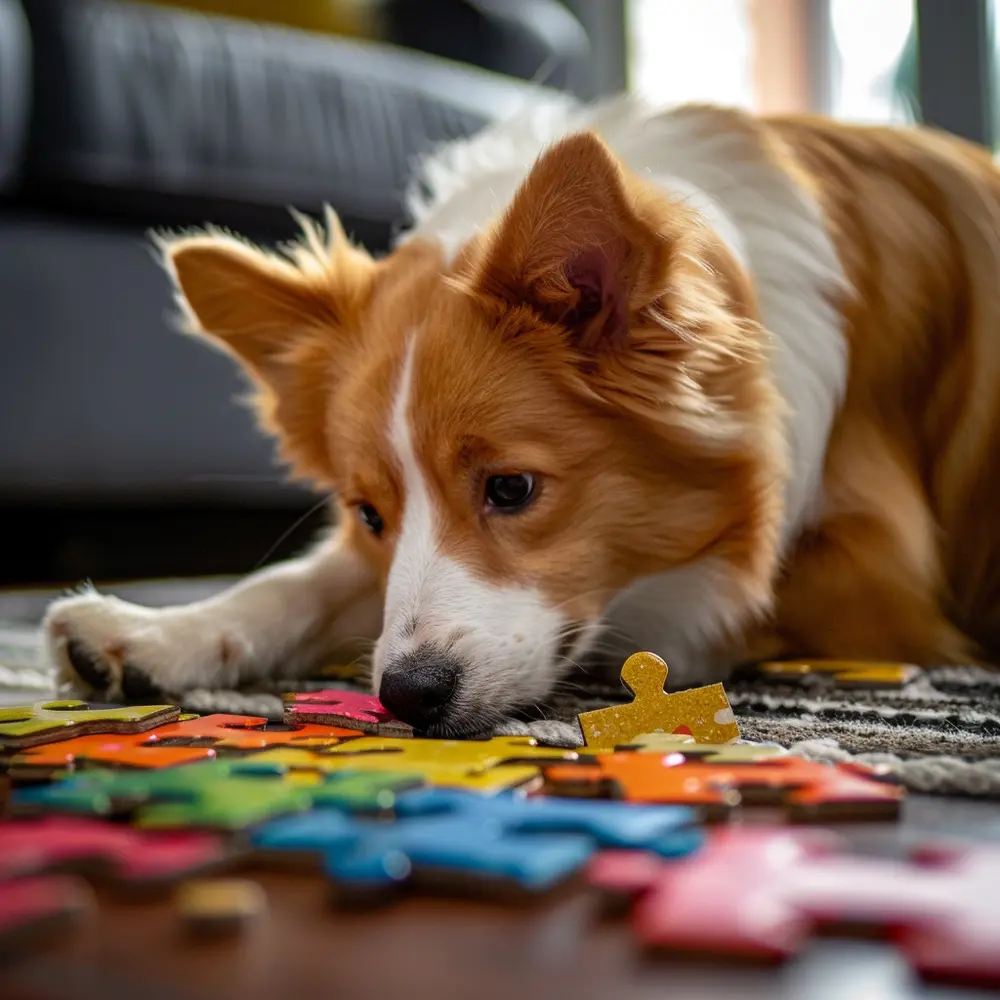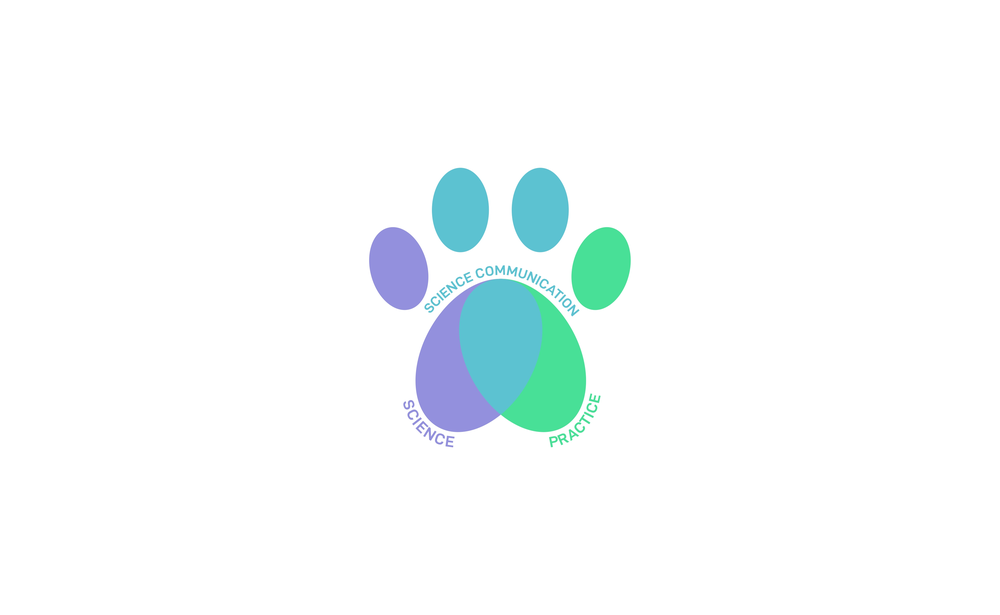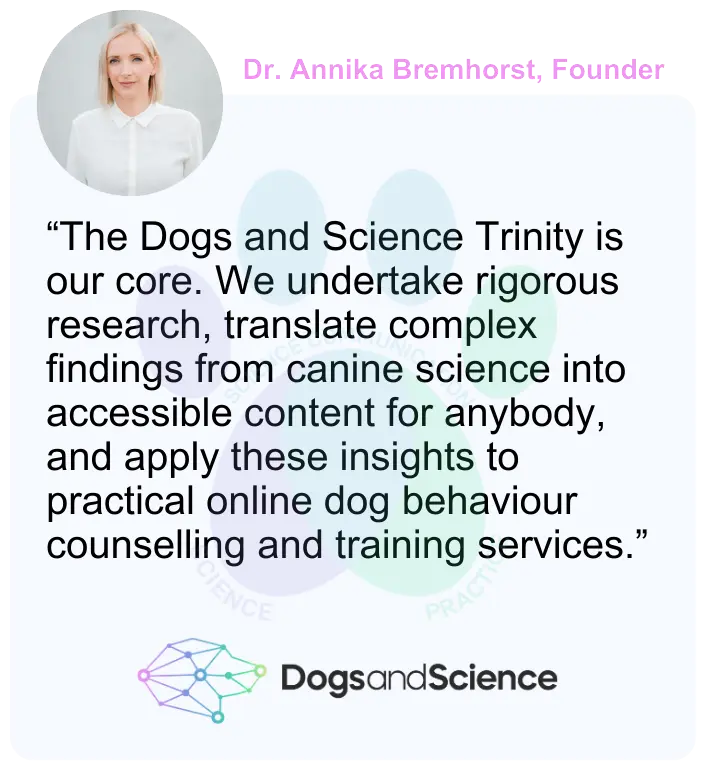Table of Contents:
Understanding the Basics of Environmental Enrichment for Dogs
Have you ever wondered how to keep your dog's mind and body engaged and lively? Environmental enrichment is the key to a well-balanced and content canine companion. At its core, environmental enrichment involves enhancing your dog's surroundings to promote behaviours natural to this species, providing mental and physical stimulation that can lead to a more fulfilled life.
Engagement in environmental enrichment can lead to significant benefits for your dog, including reduced behavioural problems, improved physical health, and enhanced mental well-being. Whether it's through sensory stimuli, like new smells or sounds, or physical challenges, such as obstacle courses—each aspect plays a crucial role in mental development and the prevention of boredom and stress.
The aim is simple: craft a setting that allows your dog to utilise their innate skills and senses, much like they would in the wild. This not only wards off potential negative behaviours but also bolsters their independence and confidence. The approach to environmental enrichment is both diverse and flexible, ranging from straightforward activities to intricate puzzles that challenge their problem-solving abilities.
Understanding the basics of environmental enrichment for dogs gives you the foundation to build upon, no matter the age or breed of your furry friend. It's about tailoring the experiences to fit your dog's unique personality and needs, ensuring they lead a happy and stimulating life.
The Importance of Environmental Enrichment in Canine Life
The vitality environmental enrichment brings to a dog's life cannot be overstated. By tapping into a dog’s natural instincts and curiosities, it provides a framework for a life filled with exploration and learning. This stimulus is essential for preventing the development of negative behaviours that can arise from boredom and anxiety, such as excessive barking, chewing, or digging.
Regular exposure to new and enriching experiences contributes to a dog's cognitive development and emotional well-being. A dog that engages with various enrichment activities is more likely to be mentally sharp and emotionally stable. This engagement can potentially stave off the development of age-related issues and preserve cognitive function well into the golden years.
Furthermore, environmental enrichment is critical for a dog's social skills, as it often involves interactive components with both humans and other animals. This interaction fosters a stronger bond between pet and owner and enables dogs to develop confidence and sociability around their fellow canines.
The joy and excitement that a dog exhibits when exploring a new toy or mastering a new game are clear indicators of the positive impact that environmental enrichment has on their overall quality of life.
In summary, environmental enrichment goes beyond mere entertainment; it is an investment in your dog's long-term health and happiness. Keeping our canine companions physically active and mentally stimulated is a responsibility that can yield immeasurable rewards for both them and us.
Environmental Enrichment Benefits and Considerations for Your Dog
| Pros of Environmental Enrichment | Considerations regarding Environmental Enrichment |
|---|---|
| Stimulates the dog’s mind and prevents boredom. | Can be time-consuming to set up different activities. |
| Encourages physical activity, which promotes health. | Some activities may require close supervision to ensure safety. |
| Reduces stress and anxiety by providing outlets for energy. | Initial costs for toys and setup might be higher. |
| Can prevent behavioural issues by keeping the dog engaged. | Not all activities are suitable for every dog; must tailor to individual needs. |
| Strengthens the bond between owner and dog through interactive play. | Professional guidance may be necessary to get started. |
| Can be a fun way to provide mental stimulation through puzzle toys and games. | Excessive enrichment without rest can lead to overstimulation. |
Types of Environmental Enrichment: Sensory, Feeding, Social, Cognitive, and Physical
Environmental enrichment can be categorised into several distinct types, each targeting different aspects of your dog's natural behaviour and abilities. These include sensory, feeding, social, cognitive, and physical enrichment, all of which contribute to a holistic approach to your dog’s well-being.
- Sensory Enrichment: This taps into your dog’s senses—smell, sight, hearing, taste, and touch. Introducing a range of smells in their environment, playing sounds of nature, or providing various textures to explore can keep a dog's senses sharp.
- Feeding Enrichment: Challenges related to food, such as hiding treats or using puzzle feeders, encourage natural foraging behaviours and make mealtime mentally stimulating and rewarding.
- Social Enrichment: Interaction with other dogs, animals, and humans nurtures your dog's social skills, with playdates or trips to the park providing invaluable opportunities for socialisation.
- Cognitive Enrichment: Activities that challenge the mind, like learning new tricks or solving puzzles, help keep your dog's brain active and engaged.
- Physical Enrichment: Exercise is crucial, and incorporating play that promotes physical activity, such as fetch or agility training, is essential for maintaining a healthy body.
Each type of enrichment is designed to simulate conditions dogs would naturally encounter in the wild, thus fulfilling their instinctual needs and preventing potential issues related to confinement or lack of mental and physical activities. By incorporating a range of enrichment activities, you are providing a more dynamic, engaging, and fulfilling environment for your dog.
Creating a Stimulating Home Environment for Your Dog
A stimulating home environment is a cornerstone of your dog's well-being and happiness. It requires creativity and an understanding of what makes your dog tick. To create such a space, consider the layout of your home and the objects you provide for your dog's interaction.
Start by designating areas within your home as play zones where your dog is encouraged to engage with toys and games. These zones signal to your dog that it’s a safe space for fun, preventing them from feeling the need to suppress their playful instincts.
In introducing novel items, aim to rotate toys and puzzles to maintain your dog’s interest. Regularly updating these objects can prevent your dog from becoming desensitized to their environment, ensuring they remain intrigued and motivated to explore.
A key to enriching your home environment is to observe your dog's preferences and behaviours closely. Some dogs may enjoy a quiet corner with a chew toy, while others might prefer a more open space to play fetch or chase. It's all about tailoring your space to support your dog’s individual needs.
Remember, your home is your dog’s habitat, and every adjustment you make can have a profound impact on their quality of life.
Lastly, it is essential to balance the excitement of new toys and games with periods of rest and relaxation. Ensure your dog has a comfortable resting area, away from the bustle of daily activities, allowing them to retreat and rejuvenate when needed.
Interactive Play and Exercise: Key Components of Physical Enrichment
Interactive play and exercise are not just activities; they are vital elements of physical enrichment for your dog. Engaging with your dog in playtime isn't only about having fun. These interactions foster a strong bond between you and your pet and provide crucial exercise that keeps them fit.
Initiate games that require both mental and physical participation, such as hide-and-seek, or use toys that encourage chasing and pouncing. Games challenging their agility, like obstacle courses that you can set up in your garden or living room, add variety to their routine and keep their bodies strong and flexible.
Structured play sessions, alongside regular walks, ensure your dog receives balanced physical engagement. Each dog, depending on breed, age, and health, will need varying levels of physical activity, so tailor these interactive sessions to meet their individual requirements.
Offering opportunities for water play, such as swimming or splashing in a paddling pool, can also be a refreshing way for your dog to exercise while keeping cool, especially during warmer months.
Through consistent and varied physical engagement, your dog’s life is enriched, promoting longevity and vitality.
Remember, the key is to be present and involved in your dog’s playtime. Your participation makes the activity more engaging for your dog and ensures they're getting the most out of their physical enrichment. At the end of the day, it enhances their quality of life and reinforces the joyous bond between you both.
Mental Stimulation: Cognitive Enrichment Activities for Dogs
Mental stimulation forms a crucial part of a dog's development and daily life. Through cognitive enrichment activities, you can sharpen your dog's mind, enhance their problem-solving skills, and reduce the likelihood of boredom-related behaviours.
Brain games such as puzzle toys that reward with treats when solved are excellent for stimulating thought. Teaching new commands or tricks also serves as mental exercise, improving their capacity for learning and memory retention. Activities like these foster focus and provide a sense of achievement for your dog.
Treasure hunts around the home or garden where your dog must locate hidden treats can mimic the mental challenges they would encounter in a natural setting. This practice not only entertains but also puts their scent detection to the test, combining both mental and sensory enrichment.
Interactive feeders, which require your dog to think and manoeuvre to access their food, encourage slow feeding and engage their cognitive functions. These feeders are not only mentally stimulating but can aid in digestion and weight management too.
Incorporating diverse cognitive enrichment activities will keep your dog mentally agile and emotionally satisfied, bringing added joy and engagement to their daily experiences.
Keep a keen eye on your dog's response to various cognitive challenges, and adjust the difficulty accordingly. Success breeds confidence, so ensure the activities are achievable while still being demanding enough to provide a meaningful challenge.
The Role of Sensory Enrichment in Enhancing Your Dog's Senses
Sensory enrichment plays a pivotal role in creating a well-rounded and invigorating environment for your dog. Each of the senses—sight, smell, hearing, taste, and touch—offers unique opportunities for enrichment, enhancing your dog's overall sensory perception and awareness.
Introducing varied textures into your dog's environment can stimulate their sense of touch. This can be achieved through different types of bedding, mats, or toys. Novel objects and surfaces encourage your dog to explore and interact with their world in new ways.
By incorporating scent games into playtime, where your dog must identify and track certain smells, you enhance their olfactory skills. This can be particularly rewarding and mentally stimulating, as the sense of smell is a dog’s most refined sense.
Visual stimulation can for instance be provided through moving toys or changing the scenery on walks.
Auditory enrichment might include playing a variety of sounds, from classical music to recordings of nature sounds. Such auditory variety can have a calming effect or serve as an interesting auditory exploration for your pet.
By mindfully integrating sensory enrichment into your dog's day-to-day activities, you are nurturing their natural instincts and enhancing their perceptual abilities, which is key to their overall well-being.
It's important to closely observe your dog's reactions to these sensory experiences to ensure they are finding them enjoyable and not overwhelming or stressful. The goal is to introduce new stimuli at a pace that is comfortable for your dog, allowing them to engage with the world around them fully and confidently.
Nutritional Enrichment: Making Mealtime More Engaging
Nutritional enrichment is about transforming your dog’s mealtime into an enjoyable and brain-engaging activity. Moving beyond the simple bowl to feed your dog can significantly improve their dining experience, bringing entertainment and cognitive challenges to what might otherwise be a mundane task.
One method to enrich your dog's eating habits is to use puzzle feeders. These devices require your pet to work for their food, which can slow down their eating pace and provide mental stimulation as they figure out how to retrieve their meal.
Another approach is to practise scatter feeding, which involves spreading your dog’s food over a large area, encouraging them to use their powerful sense of smell to hunt down each piece. This method taps into their instinctual foraging behaviour and can also be a great way to give them extra physical exercise.
For dogs that eat too quickly, slow feeders can be an excellent investment. These special bowls have built-in obstacles that dogs need to navigate around to reach their food, which helps prevent indigestion and bloating caused by rapid eating.
By enriching your dog’s nutritional routines, you’re not only promoting healthier eating habits but also contributing to their mental health and reducing the likelihood of boredom.
Keep an eye on how your dog responds to these new feeding methods. While some may relish the challenge, others may require a gentler introduction. Always choose safe, non-toxic materials designed specifically for pets and ensure they are appropriate for your dog's size and chewing habits.
Social Enrichment: Fostering Positive Interactions for Your Dog
Social enrichment is crucial in nurturing well-adjusted, friendly dogs that are comfortable with various interactions. Positive engagement with humans and other animals can significantly enhance a dog's social skills and overall happiness.
Scheduling regular playdates with other dogs is an excellent way for your pet to engage in social play and learn appropriate canine interactions. Just as humans benefit from socialising, these interactions can reduce stress and anxiety in dogs, leading to improved behaviour and emotional stability.
Attending training classes offers a dual benefit of education and socialisation. Classes provide a structured setting for your dog to meet others while learning commands and manners, aiding in their cognitive and social growth.
Visiting dog-friendly parks or establishments lets your dog experience new environments while interacting with a wider range of people and pets, broadening their social horizons.
Integrating social enrichment into your dog's routine fosters a sense of community and belonging, which is essential for their psychological well-being.
Be mindful of your dog's temperament and history when introducing them to new social scenarios. Some dogs may require gradual exposure to build their confidence, whereas others might dive right into new friendships. Always monitor interactions to ensure they are positive and safe for everyone involved.
Safety First: Ensuring Safe Environmental Enrichment Practices
While environmental enrichment can offer a host of benefits for your dog, it's paramount that safety remains the top priority. It's essential to select activities and items that will not pose any harm to your pet.
Begin by choosing toys that are non-toxic and appropriate for your dog's size and strength. Avoid toys with small parts that could be swallowed or chewed off, presenting choking hazards. Regularly inspect your dog's toys for signs of wear and tear and replace them as necessary.
Any DIY enrichment setups, like homemade obstacle courses or puzzle games, need to be constructed safely, with no sharp edges or loose components. Supervision is key when introducing your dog to new challenges; you should always be present to navigate any potential risks.
Similarly, it's important to introduce new activities gradually, particularly for dogs that are older or have health issues. Sudden or intense changes in routine can lead to stress or injury, so pace the introduction of new enrichments according to your dog's comfort and capability.
Responsible enrichment practices mean considering your dog's individual needs and limitations, thereby fostering a safe environment for exploration and play.
Be aware of your environment as well; ensure that areas where your dog plays are secure and free from hazards like traffic or toxic plants. Ultimately, your careful attention to safety can help guarantee that the enrichment activities provide the intended positive effects on your dog's well-being.
Monitoring Your Dog's Response to Enrichment Activities
Attentive observation is crucial as you introduce your dog to various enrichment activities. Monitoring your dog's responses allows you to tailor experiences to their preferences and ensures they remain comfortable and engaged.
Look for signs of enthusiasm and interest, such as a wagging tail or an eager posture when engaging with new toys or activities. Conversely, be alert for signs of stress or anxiety, like avoidance, excessive panting, or reluctance to interact, which indicate the need to adjust the level of challenge.
It's also vital to gauge the difficulty level of cognitive games or puzzles. While a challenge is beneficial, it shouldn't be so difficult that it frustrates your dog. Aim for a balance where your dog is stimulated but not discouraged.
Keep an eye on your dog's physical reaction to exercise and play. Ensure that they are not overexerting themselves, especially in hot weather or if they have existing health concerns. Adequate water and breaks are important to maintain a healthy activity level.
Remember, individual dogs will have unique inclinations and thresholds; what excites one dog may overwhelm another. Tailoring enrichment to your dog's individual needs is the essence of effective environmental enrichment.
Regularly assessing and adapting your approach to environmental enrichment is a dynamic process that can significantly enhance your dog's quality of life and strengthen the bond you share with them.
Incorporating Environmental Enrichment into Your Dog's Daily Routine
Integrating environmental enrichment into your dog's daily routine is an ongoing and rewarding process. The key is to weave enriching activities into their regular schedule to provide consistency and structure.
Begin the day with a stimulating walk, incorporating different routes and allowing time for your dog to explore and interact with their surroundings. Engaging with different environments provides mental and physical stimulation right from the start of the day.
Throughout the day, incorporate short training sessions or playtime that utilise puzzle toys to break up periods of inactivity. This keeps their mind active and bodies moving, reducing restlessness.
Even mealtime can be an enriching experience. Replace traditional feeding bowls with interactive feeders to prolong eating time and provide a challenging activity that engages their brain.
Take a moment in the evening to connect with your dog through calm, relaxing activities. Gentle petting or brushing can soothe your dog and strengthen the emotional bond between you two.
Ensuring that your dog's life is enriched through thoughtful, daily activities supports their overall well-being and deepens the joyful companionship they offer.
Adjusting the type and amount of enrichment to fit your dog’s age, health, and temperament is important to keep them engaged without becoming overwhelmed. By mindfully scheduling these activities, you're providing a balanced lifestyle that caters to your dog's innate needs.
Advanced Environmental Enrichment: Taking It to the Next Level
For those looking to elevate their dog's enrichment experience, advanced environmental enrichment can provide an added layer of complexity and joy to their lives. It involves novel approaches that can further stimulate your dog's cognitive and sensory faculties.
Consider setting up complex puzzle challenges that require sequential steps to solve. These can include multi-stage toys or homemade puzzles that encourage dogs to think through a series of actions to reach a reward.
Technology can also play a role in advanced enrichment. Interactive gadgets and apps designed for dogs can offer a variety of engaging scenarios, from simulated chasing games to interactive video calls.
Another facet is to incorporate dog sports such as mantrailing. This not only provides physical exercise but also requires mental focus and fosters a deep sense of teamwork between dog and owner.
Advanced enrichment challenges the status quo, encouraging dogs to use their intellect and physical abilities in new and diverse ways, promoting growth and satisfaction.
As with any enrichment, it's essential to introduce more complex activities gradually, ensuring they're a good fit for your dog's personality and capability. Always prioritize fun and safety, celebrating each milestone as your dog masters these new and exciting challenges.
Troubleshooting Common Challenges in Environmental Enrichment
Implementing environmental enrichment for your dog may come with its set of challenges. Recognizing and addressing these common hurdles can help ensure your enrichment plans are successful and enjoyable for your pet.
One common issue is a lack of engagement. If your dog seems uninterested in certain toys or activities, it may simply mean those aren't stimulating for them. Experiment with different types of enrichment to discover what they enjoy most, taking cues from their natural behaviours and preferences.
Overstimulation can also be a concern, particularly with more sensitive dogs. If an activity is causing stress, it's important to step back and simplify the challenge, or introduce new stimuli more slowly and in a controlled manner.
Budget constraints might limit options for store-bought enrichment toys. However, many effective enrichment tools can be created at home using common household items. Always ensure that these DIY toys are safe and free from sharp edges or harmful substances.
Some dogs may become fixated on a particular toy or game, leading to possessive behaviours. In this case, it's beneficial to regularly rotate toys to prevent over-attachment and keep their environment dynamic.
Addressing these troubleshooting aspects promptly can enhance the environmental enrichment experience for your dog, making it a positive element of their routine.
Judging when and how to modify activities is part of the process, as is being adaptable and creative with the enrichment solutions you offer your dog.
Conclusion: The Lifelong Benefits of Environmental Enrichment for Dogs
Environmental enrichment is more than just a series of activities; it's a commitment to enhancing the quality of life for our dogs throughout their entire lifespan. By embracing the principles of enrichment, we provide dogs with a nurturing environment that caters to their physical needs and mental curiosity.
From bolstering their physical health to sharpening their cognitive abilities, enrichment has profound and lasting benefits. Dogs that enjoy a variety of enriching experiences tend to demonstrate better behaviour, show less anxiety, and exhibit a greater capacity for learning and adaptability.
Moreover, the bond that enrichment fosters between dog and owner is irreplaceable. It's built on mutual trust and understanding, strengthened through shared experiences and the joy found in each new discovery.
Ultimately, environmental enrichment secures a fulfilling life for our dogs—one filled with happiness, health, and harmony. It's a gift that continually rewards both the giver and the receiver, and its value can never be understated.
In closing, the journey of providing environmental enrichment is one of continuous learning and love. As we enrich our dogs' lives, they, in turn, enrich ours, creating a circle of companionship that spans through the years.
Essential Guide to Environmental Enrichment for Dogs
What is environmental enrichment for dogs?
Environmental enrichment for dogs entails enhancing your dog's living space and routine to encourage natural behaviours and provide mental and physical stimulation. This includes introducing various activities and items such as toys, obstacles, scents, and interactive games that cater to their senses and cognitive abilities.
Why is environmental enrichment important for dogs?
Environmental enrichment is important because it addresses a dog's instinctual needs, prevents boredom, reduces instances of negative behaviour, and promotes overall well-being. It is essential for maintaining a healthy balance of physical exercise and mental activity, leading to a happier and more well-rounded dog.
How can I provide sensory enrichment for my dog?
Sensory enrichment can be achieved by providing a variety of stimuli that appeal to your dog's senses. Introduce new scents through scented toys or herbs, offer different textures in bedding or toys for touch, use sound-producing items or music for auditory stimulation, and provide visually stimulating toys or environments to explore.
What are some cognitive enrichment activities for dogs?
Cognitive enrichment can include teaching new tricks, providing puzzle toys, setting up treat-finding games, and using interactive feeders that challenge your dog to think and solve problems in order to receive their food. These activities support mental agility and cognitive health.
Are there safety considerations to keep in mind when implementing environmental enrichment?
Yes, it's paramount to ensure all enrichment activities and toys are safe for your dog. Choose items appropriate for your dog's size and strength, check regularly for wear and tear, and supervise new activities. Additionally, introduce changes gradually to avoid stress or injury, and ensure the environment is secure and free from hazards.






